Basic rules for processing tomatoes with boric acid: prepare a solution and spray, avoiding mistakes
Tomatoes are an unpretentious crop that, when properly sown, does not need frequent fertilization. However, often problems in growing tomatoes are associated with an imbalance of nutrients in the soil.
Boron is one of the most valuable trace elements for nightshades. How to properly process tomatoes with boric acid, how safe it is, what nuances should be taken into account when diluting the product - you will learn all this from the article.
The content of the article
What does boron give to tomatoes
Boric acid is a colorless and odorless crystalline substance that dissolves well in warm water. The tool has found application in vegetable gardens - it is used to feed seedlings. The substance does not accumulate in the soil, as the plants actively consume it. To make up for the boron deficit, gardeners from time to time enrich the soil with it.
The trace element plays an important role in the correct development of tomatoes: its lack negatively affects flowering and productivity. Boron enhances the flow of sugar to the generative organs, thereby increasing plant productivity and improving the taste of fruits. Vegetable growers noticed that boric acid spraying stimulates the growth of the root system and the ground part of the crop and protects against diseases.
reference... Boron is also used to fertilize cucumbers, beets, potatoes, grapes, strawberries, apples and pears.
The product normalizes the synthesis of plant substances, stimulates metabolic processes and increases the chlorophyll coefficient. Thanks to these properties, the tomato bush acquires resistance to adverse factors and diseases.
Top dressing with boron preserves the number of ovaries and promotes the formation of new plant points for the stems.
The benefits and harms of boric acid
Boric acid is considered the most economical, affordable and easy-to-use source of the micronutrient. This preparation contains the form of a substance necessary for the growth of crops.
Like any fertilizer, boric acid has strengths and weaknesses.
Benefits:
- increases flowering;

- protects against the formation of barren flowers and shedding of ovaries;
- promotes the development of a powerful root system;
- protects the plant from rotting at high humidity;
- increases yield by 20%;
- increases the palatability of fruits;
- accelerates the ripening of tomatoes by 1-2 weeks;
- increases resistance to adverse weather conditions;
- improves the absorption of mineral and organic substances;
- reduces the risk of developing late blight, powdery mildew and leaf spot;
- destroys insect pests;
- has a low hazard class.
Disadvantages:
- high probability of plant burns if the dosage is violated;
- an excess of substance causes deformation and death of the bush.
An excess of boron in the soil can be determined by the appearance of plants: the leaves acquire an unnatural glossy appearance, their edges begin to curl inward, and the base of the plate bends into a dome-shaped shape.
The boron balance in the soil is normalized with potassium. A week after the introduction of the substance, it is recommended to feed the affected bushes with nitrogenous fertilizers.
When boron is needed for tomatoes
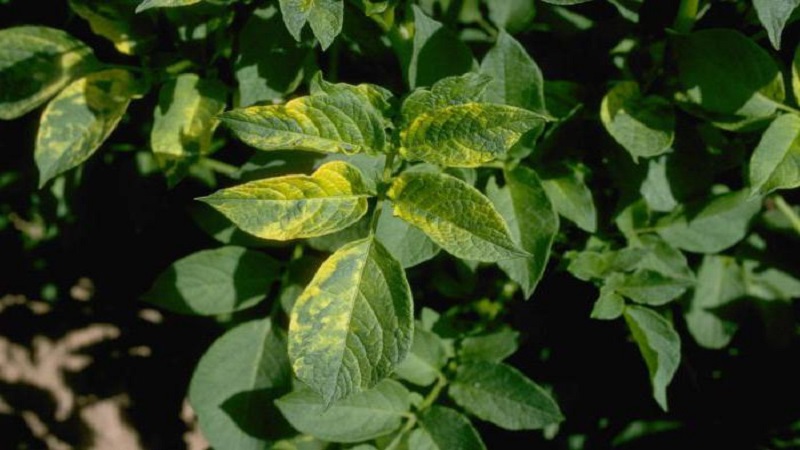
Fertilizing tomatoes with boric acid is done several times per season.Vegetable growers recommend processing the seed material before planting, since this measure protects the seedlings from diseases. Foliar processing during the flowering period enhances the growth of flowers and prevents them from shedding. Top dressing during the fruiting period protects the fruits from spoilage, accelerates their ripening, improves taste and presentation.
The bushes are sprayed with boric acid when signs of a substance deficiency appear.
How to identify a shortage
Boron deficiency is characteristic of poor sandy loam or sandy soil. In such a soil, the microelement does not linger for a long time, so the plants suffer from its deficiency.
Signs that a culture needs a substance:
- stems break easily and quickly;
- the leaves are deformed, curled around the edges;
- the leaf plate loses its color;
- the upper shoots dry up;
- the veins on the leaves become dry, turn yellow or black;
- brown or light spots appear on the tops;
- the base of the stem turns black or dries up;
- the plant blooms poorly;
- flowers and ovaries crumble.
How to prepare a solution
To prepare the mixture, boric acid is used, produced by manufacturers in the agrosphere. The packaging of the product contains complete instructions for diluting the substance.
Important! Boric acid does not dissolve in cold water. A warm liquid is required to prepare the solution.
It is important to ensure that the crystals of the substance are completely dissolved in water, otherwise this can lead to leaf burns. As soon as the solution cools down, the bushes are treated with it.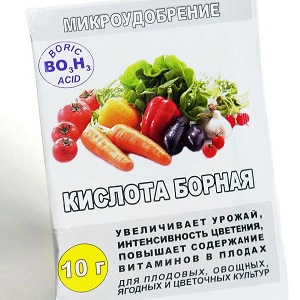
The recommended proportions should not be overestimated, since an overabundance of boron negatively affects the growing season of tomatoes. Novice gardeners often worry about whether they diluted the acid correctly. Purchase a diluted liquid mixture to prevent concentration errors.
If you decide to prepare a solution on your own and are in doubt about the proportions, reduce the concentration of the trace element by increasing the volume of water.
Step-by-step processing instructions
Boric acid is used for several types of procedures: seed treatment, watering and spraying. If leaves curl on the bushes, they need to be sprayed; if they began to fall off, watering with boron solution will help.
Seed treatment
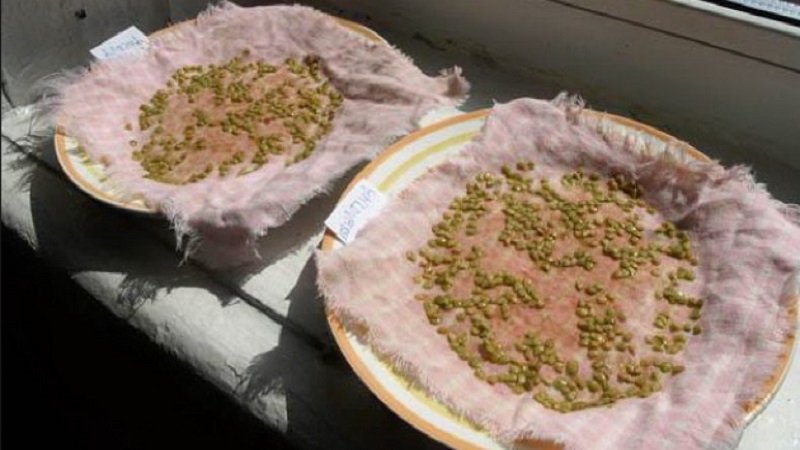
Treatment of planting material with boric acid is a good preventive measure against many diseases. Procedure:
- For 1 liter of warm water, 0.2 g of the substance is needed.
- The solution is poured into a container.
- Gauze or cloth is placed on top of the liquid, and seeds are poured on top.
- Leave for 1 day.
- The procedure is repeated before direct planting into the ground.
Before planting seedlings in a summer cottage, the land is also treated with boric acid (2 g per 10 l of water).
Watering
For root dressing, 10 g of dry matter is taken for 10 liters of water. Before adding boric acid to the soil, it is necessary to water the soil abundantly with water, otherwise the roots of the plants will be burnt.
Important! When preparing the solution, calculate the proportions correctly so as not to harm the plants.
Moisten the soil with the resulting mixture near the bushes themselves and in the aisles. For 1 m2, 1 liter of solution is needed.
Spraying

Foliar treatment with boric acid is considered more effective. The procedure is carried out using a finely dispersed spray bottle. All parts of the plant are sprayed - leaves, flowers and ovary.
The procedure takes place in 3 stages:
- The beds are treated with a weak solution of manganese.
- After a week, use a boron solution.
- A week later, it is treated with iodine solution.
If tomatoes are sprayed to protect against late blight, 1 tsp. the substances are added to 10 liters of water. If boron is needed to preserve flowers and ovary, 10 g is diluted in 10 liters of water.
For foliar dressing, choose good weather. Optimal conditions - air temperature +25 ° С with high humidity. If the temperature rises and the humidity decreases, the solution on the leaves will dry out quickly and will not give the desired effect.
When to process tomatoes and how often
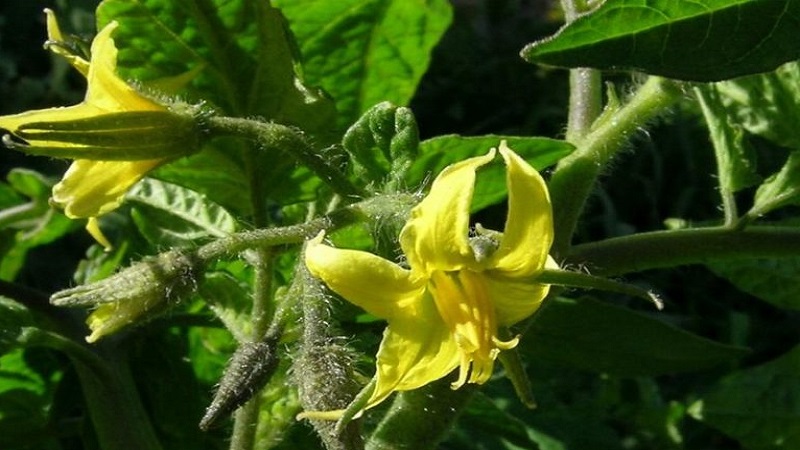
Boric acid is an effective remedy. But in order for it to be useful, it is important to know the conditions for its use:
- The pre-sowing technique for processing tomatoes includes two stages: soaking the seeds in a solution for 1 day and introducing the substance into the holes before planting seedlings.
- The soil is fertilized with a boron solution 1 time - during the flowering period of plants. To fertilize the soil for 10 liters of water, take 10 g of the substance. Before planting seedlings in a summer cottage, the land is also treated with boric acid (2 g per 10 l of water).
- They begin to spray the bushes in June. The first time is before flowering, when buds are forming. The second is during mass flowering. The third spraying is carried out at the beginning of fruiting.
- Tomatoes are watered with boron with the appearance of ovaries. During the flowering period, root fertilization is undesirable, as it can slow down the growth and development of the bushes.
Boric acid treatment can be unscheduled when the plant needs a trace element or there is a threat of late blight infection. The interval between spraying should be 10 days.
After planting the bushes in the ground, it is not recommended to use such top dressing. At this stage, it is better to fertilize the beds with mineral complexes. There is a great risk that the excess of the concentration of the substance will destroy the young shoots.
Outdoor and greenhouse use
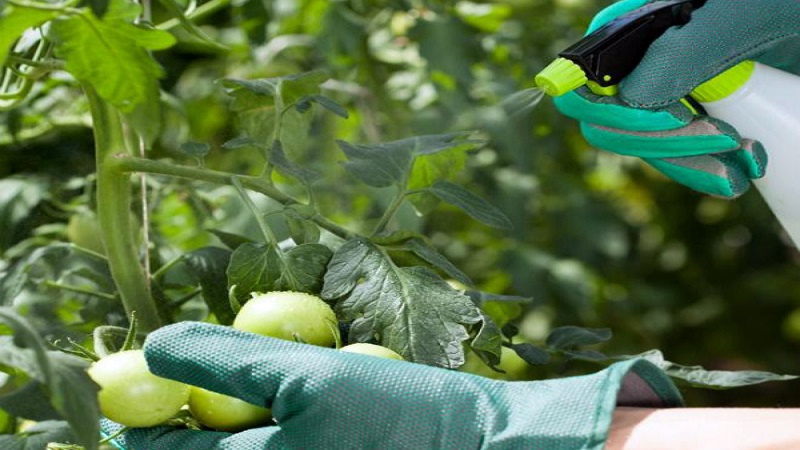
Foliar treatment in open beds should be carried out on a calm day. The best time for the procedure is early morning or evening. If it rains after spraying, repeat the treatment.
Plants grown in greenhouses, greenhouses, as well as at home in hydroponics, boron is especially necessary. Tomatoes grow weak indoors. Boric acid treatment strengthens the stem, helps tomatoes grow green mass and accelerates flowering.
To increase the effectiveness, the substance is combined with urea and manure. In the greenhouse, the likelihood of developing diseases increases, therefore, for prevention, treatment is carried out once a month (2 g per 10 liters of water).
reference... Boric acid eliminates insect pests indoors (for example, hornets and ants).
Can the solution harm
The product has a very low level of danger to humans. If a solution gets on the skin during treatment, do not be afraid of burns. However, it should be noted that the substance accumulates in the human body and is excreted very slowly.
When handling boric acid, do not neglect personal protection: wear protective clothing, gauze bandages and gloves.
High concentration of the product is dangerous for pets. The substance may cause chronic diseases.
An overabundance of boron in tomatoes is rare: the culture takes from the soil the amount of valuable elements it needs. However, excess substance accumulates in the fruit and can cause food poisoning in humans. Therefore, it is important to observe the dosage and monitor the condition of the plants.
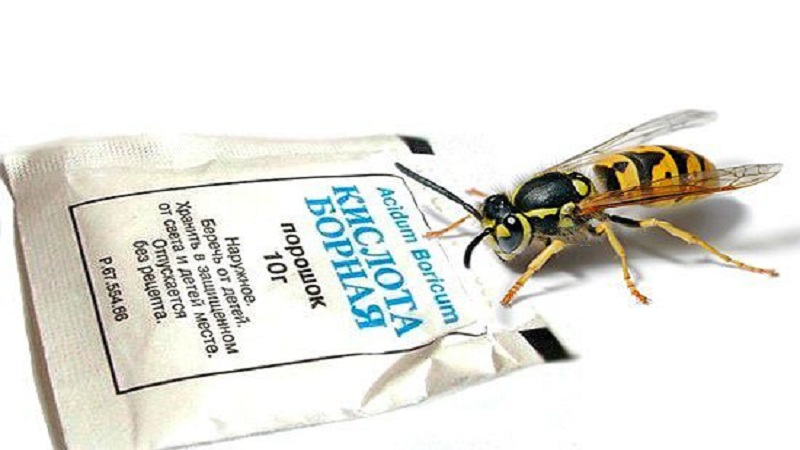
Tips from experienced gardeners
When working with boric acid, it is worth considering the recommendations of vegetable growers:
- Do not use cold water to prepare the solution. The liquid temperature should not be lower than the soil temperature.
- Spraying should be carried out at an air temperature of + 20 ... + 25 ° С with high air humidity.
- Before treating all plants, try the solution on one bush.
- If after the first treatment the seedlings look bad, you should stop using the product (the boron concentration may have been exceeded).
- Do not exceed the dose of the substance indicated in the instructions.
Reviews of vegetable growers
Farmers value the product's safety and effectiveness.
Anton, Kaliningrad: “I have been using boric acid for a long time, there is no better fertilizer for tomatoes. It is important to take into account the condition of the bush: if the leaves are curled, spraying is necessary, and if they begin to fall off, it is better to apply top dressing under the bush. "
Semyon, Krasnodar Territory: “I use boron feeding, as it is the safest for children.The solution does not belong to harmful pesticides, which means that ripe tomatoes will not cause any harm to the body. "
Evgeny, Moscow region: "I use boric acid only for processing adult bushes. For seedlings I use ready-made mineral complexes, which include boron. It's much safer this way: young tomatoes will not suffer from an increase in the concentration of the substance. ".
Read also:
Secrets of experienced summer residents - spraying tomatoes with iodine.
Conclusion
Boric acid is an effective and affordable top dressing for tomatoes. An increase in the ratio of a substance in a solution will not give the desired results - on the contrary, an overdose will lead to the death of plants. Fertilize tomatoes during flowering and fruiting. In an earlier period, it is better to use mineral complexes.
When used correctly, the substance allows you to get a large harvest, protect the beds from diseases, and reduce the cost of fertilizers and feeding.